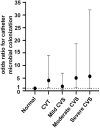Central Venous Disease Increases the Risk of Microbial Colonization in Hemodialysis Catheters
- PMID: 34497811
- PMCID: PMC8419307
- DOI: 10.3389/fmed.2021.645539
Central Venous Disease Increases the Risk of Microbial Colonization in Hemodialysis Catheters
Abstract
Objectives: Tunneled-cuffed catheters (TCCs) are widely used in maintenance hemodialysis patients. However, microbial colonization in catheters increases the likelihood of developing various complications, such as catheter-related infection (CRI), catheter failure, hospitalization, and death. Identification of the risk factors related to microorganism colonization may help us reduce the incidence of these adverse events. Therefore, a retrospective analysis of patients who underwent TCC removal was conducted. Methods: From a pool of 389 adult patients, 145 were selected for inclusion in the study. None of the patients met the diagnostic criteria for CRI within 30 days before recruitment. The right internal jugular vein was the unique route evaluated. The catheter removal procedure was guided by digital subtraction angiography. Catheter tips were collected for culture. Biochemical and clinical parameters were collected at the time of catheter removal. Results: The average age of this cohort was 55.46 ± 17.25 years. A total of 45/145 (31.03%) patients were verified to have a positive catheter culture. The proportions of gram-positive bacteria, gram-negative bacteria, and fungi were 57.8, 28.9, and 13.3%, respectively. History of CRI [odds ratio (OR) = 2.44, 95% confidence interval (CI) 1.09 to 5.49], fibrin sheath (OR = 2.93, 95% CI 1.39-6.19), white blood cell (WBC) count ≥5.9 × 109/l (OR = 2.31, 95% CI 1.12-4.77), moderate (OR = 4.87, 95% CI 1.61-14.78) or severe central venous stenosis (CVS) (OR = 4.74, 95% CI 1.16-19.38), and central venous thrombosis (CVT) (OR = 3.41, 95% CI 1.51-7.69) were associated with a significantly increased incidence of microbial colonization in a univariate analysis. Central venous disease (CVD) elevated the risk of microbial colonization, with an OR of 3.37 (1.47-7.71, P = 0.004). A multivariate analysis showed that both CVS and CVT were strongly associated with catheter microbial colonization, with ORs of 3.06 (1.20-7.78, P = 0.019) and 4.13 (1.21-14.05, P = 0.023), respectively. As the extent of stenosis increased, the relative risk of catheter microbial colonization also increased. In patients with moderate and severe stenosis, a sustained and significant increase in OR from 5.13 to 5.77 was observed. Conclusions: An elevated WBC count and CVD can put hemodialysis patients with TCCs at a higher risk of microbial colonization, even if these patients do not have the relevant symptoms of infection. Avoiding indwelling catheters is still the primary method for preventing CRI.
Keywords: catheter-related infection; central venous stenosis; central venous thrombosis; microbial colonization; tunneled cuffed catheter.
Copyright © 2021 Liang, Liu, Chen, Li, Zhao, Liu and Wang.
Conflict of interest statement
The authors declare that the research was conducted in the absence of any commercial or financial relationships that could be construed as a potential conflict of interest.
Figures


Similar articles
-
Longer duration of catheter patency, but similar infection rates with internal jugular vein versus iliac vein tunneled cuffed hemodialysis catheters: a single-center retrospective analysis.Int Urol Nephrol. 2015 Oct;47(10):1727-34. doi: 10.1007/s11255-015-1089-7. Epub 2015 Sep 2. Int Urol Nephrol. 2015. PMID: 26329742
-
Comparison of Oligon catheters and chlorhexidine-impregnated sponges with standard multilumen central venous catheters for prevention of associated colonization and infections in intensive care unit patients: a multicenter, randomized, controlled study.Crit Care Med. 2012 Feb;40(2):420-9. doi: 10.1097/CCM.0b013e31822f0d4b. Crit Care Med. 2012. PMID: 21926583 Clinical Trial.
-
Tunneled hemodialysis catheters: use of a silver-coated catheter for prevention of infection--a randomized study.Radiology. 1998 May;207(2):491-6. doi: 10.1148/radiology.207.2.9577500. Radiology. 1998. PMID: 9577500 Clinical Trial.
-
Rates of infection for single-lumen versus multilumen central venous catheters: a meta-analysis.Crit Care Med. 2003 Sep;31(9):2385-90. doi: 10.1097/01.CCM.0000084843.31852.01. Crit Care Med. 2003. PMID: 14501971 Review.
-
Do central venous catheters have advantages over arteriovenous fistulas or grafts?J Nephrol. 2006 May-Jun;19(3):265-79. J Nephrol. 2006. PMID: 16874685 Review.
Cited by
-
Challenges and Opportunities: Interplay between Infectious Disease and Antimicrobial Resistance in Medical Device Surface Applications.ACS Omega. 2025 May 20;10(21):20968-20983. doi: 10.1021/acsomega.5c01011. eCollection 2025 Jun 3. ACS Omega. 2025. PMID: 40488087 Free PMC article. Review.
-
Sustained low catheter related infection (CRI) incidence in an observational follow-up study of 9924 catheters using automated data scripts as quality assurance for central venous catheter (CVC) management.Infect Prev Pract. 2023 Feb 19;5(2):100273. doi: 10.1016/j.infpip.2023.100273. eCollection 2023 Jun. Infect Prev Pract. 2023. PMID: 36926533 Free PMC article.
References
LinkOut - more resources
Full Text Sources
Research Materials
Miscellaneous

